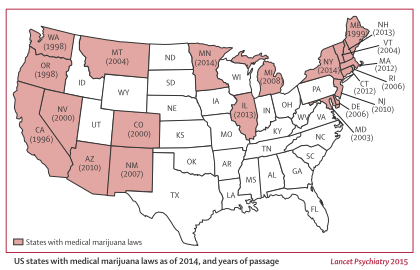A STUDY analyzing 24 years of data (1991 to 2014) from over one million adolescents in the United States has found no evidence that legalizing the use of marijuana for medical purposes leads to increased use among teenagers.
Since 1996, the District of Columbia and 23 U.S. states have passed laws allowing the medical use of marijuana. State legalization of medical marijuana has raised concerns about increased accessibility and acceptability of marijuana to teenagers.
 In this study, published in The Lancet Psychiatry [1], researchers examined the relationship between the legalization of medical marijuana and adolescent marijuana use by analyzing national “Monitoring the Future” survey data [2] from over one million students in the 8th, 10th, and 12th grades (aged 13–18) between 1991 and 2014 – a period when 21 contiguous states passed laws allowing marijuana use for medical purposes (see figure).
In this study, published in The Lancet Psychiatry [1], researchers examined the relationship between the legalization of medical marijuana and adolescent marijuana use by analyzing national “Monitoring the Future” survey data [2] from over one million students in the 8th, 10th, and 12th grades (aged 13–18) between 1991 and 2014 – a period when 21 contiguous states passed laws allowing marijuana use for medical purposes (see figure).
Dr. Deborah Hasin, professor of Epidemiology at Columbia University Medical Center (New York), and colleagues found that although marijuana use in the previous 30 days was more prevalent in states that enacted medical marijuana laws than those that did not, rates of adolescent marijuana use did not increase after these laws were introduced. These findings persisted Even after taking into account individual, e.g. age, ethnicity; school, public versus private school; and state-level factors, such as proportion of each state’s population who were male or white, which can affect marijuana use.
“Our findings provide the strongest evidence to date that marijuana use by teenagers does not increase after a state legalizes medical marijuana. Rather, up to now, in the states that passed medical marijuana laws, adolescent marijuana use was already higher than in other states,” said Dr. Hasin. “Because early adolescent use of marijuana can lead to many long-term harmful outcomes, identifying the factors that actually play a role in adolescent use should be a high research priority.”
Writing in a linked Comment, Dr. Kevin Hill from the Division of Alcohol and Drug Abuse, McLean Hospital (Belmont, MA, USA), writing in the Comment, said, “The growing body of research that includes this study suggests that medical marijuana laws do not increase adolescent use, and future decisions that states make about whether or not to enact medical marijuana laws should be at least partly guided by this evidence. The framework of using a scientific method to challenge what might be ideological beliefs must remain an important driver of future research on marijuana policy.”
[1] Deborah S Hasin, Melanie Wall, Katherine M Keyes, Magdalena Cerdá, John Schulenberg, Patrick M O’Malley, Sandro Galea, Rosalie Pacula, Tianshu Feng. "Medical marijuana laws and adolescent marijuana use in the USA from 1991 to 2014: results from annual, repeated cross-sectional surveys", Lancet Psychiatry 2015, Published Online June 16, 2015.
[2] Monitoring the Future is an ongoing study of the behaviors, attitudes, and values of American secondary school students, college students, and young adults. Each year, a total of approximately 50000 8th, 10th, and 12th grade students are surveyed (12th graders since 1975, and 8th and 10th graders since 1991)
Originals













